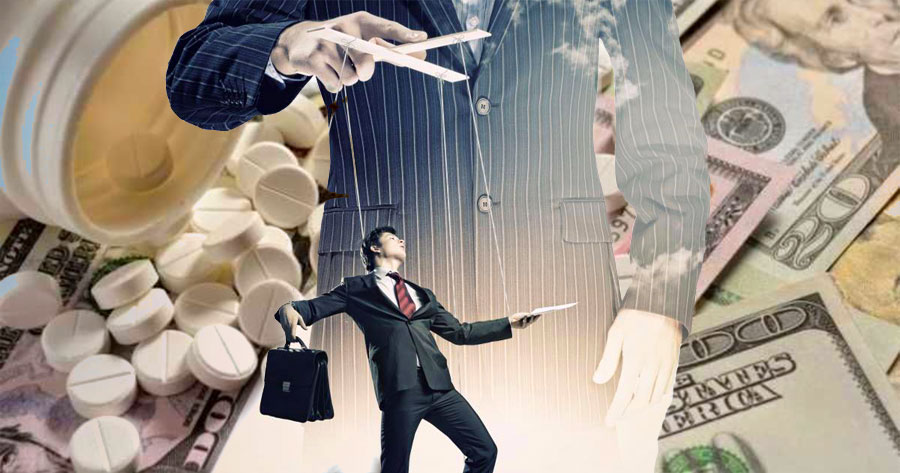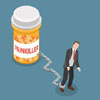Organized Crime: The Business Model Of Big Pharma ~ Part II
 by Peter C. Gotzsche
by Peter C. Gotzsche
7 Johnson & Johnson Fined More Than $1.1 Billion In 2012
A jury found that the company and its subsidiary Janssen had downplayed and hidden risks associated with its antipsychotic drug Risperdal (risperidone). The judge found nearly 240,000 violations under Arkansas’ Medicaid-fraud law. Jurors returned a quick verdict in favor of the state, which had argued that Janssen lied about the potentially life-threatening side effects of Risperdal which, like other antipsychotic drugs, include death, strokes, seizures, weight gain and diabetes. The FDA had ordered Janssen to issue a letter to doctors correcting an earlier letter saying the drug didn’t increase the risk of developing diabetes. Janssen continued to maintain after the verdict that it didn’t break the law. Previous verdicts against the company a few months earlier included a $327 million civil penalty in South Carolina and a $158 million settlement in Texas.
The worst of all this was that the crimes hit hard also on children. More than a quarter of Risperdal’s use was in children and adolescents, including non-approved indications, and a panel of federal drug experts concluded that the drug was used far too much. A world-renowned child psychiatrist, Joseph Biederman from Harvard, pushed the drug heavily to children and also extorted the company. Internal emails released for use in court cases revealed that Biederman was furious after Johnson & Johnson rejected a request he had made to receive a $280,000 research grant. A company spokesperson wrote: ‘I have never seen someone so angry … Since that time, our business became non-existent [sic] within his area of control.’
The fraud case could become even bigger. In April 2012, the US government stated in a motion in a potential multibillion-dollar healthcare fraud case against Johnson & Johnson that Alex Gorsky, Vice President of Marketing, who was set to become Johnson & Johnson’s next chief executive officer, was actively involved and had firsthand knowledge of the alleged fraud. The allegations were that Johnson & Johnson paid kickbacks to induce Omnicare, the nation’s largest nursing home pharmacy, to purchase and recommend Risperdal and other of the company’s drugs. The company didn’t inform Omnicare or members of Janssen’s sales staff that the FDA had warned the company that marketing Risperdal as safe and effective in the elderly would be false and misleading because the drug had not been adequately studied in that population, or that the FDA had rejected the company’s attempt to get approval to market Risperdal for treatment of psychotic and behavioural disturbances in dementia (by far the most prevalent use of Risperdal in Omnicare-served nursing facilities) because of inadequate safety data. Despite the weight of federal and state investigations of the Risperdal allegations, Johnson & Johnson’s board of directors rewarded Gorsky by selecting him to be the next CEO. It’s like in the mob: the greater the crime, the greater the advancement.
8 Merck To Pay $670 Million Over Medicaid Fraud In 2007
Merck had failed to pay the appropriate rebates to Medicaid and other government healthcare programs, and had also paid kickbacks to doctors and hospitals to induce them to prescribe various drugs. The allegations were brought in two separate lawsuits filed by whistle blowers, and one of them would receive $68 million. From 1997 to 2001, Merck’s sales force used approximately 15 different programs to induce doctors to prescribe its drugs. These programs primarily consisted of excess payments to doctors disguised as fees for ‘training’, ‘consultation’ or ‘market research’. The government alleged that these fees were illegal kickbacks intended to induce the purchase of Merck drugs. Merck agreed to a Corporate Integrity Agreement.
9 Eli Lilly To Pay More Than $1.4 Billion For Illegal Marketing In 2009
Eli Lilly entered into a settlement with the Department of Justice concerning a wide-ranging, off-label marketing scheme for its top-selling antipsychotic drug, Zyprexa (olanzapine), with worldwide sales of nearly $40 billion between 1996 and 2009. In the settlement, Eli Lilly would pay $800 million in civil penalties and pleaded guilty to criminal charges, paying an additional $600 million fine. The allegations were raised by six whistle blowers from Lilly who would share in approximately 18% of the federal and qualifying states’ recoveries. All whistle blowers were fired or forced to resign by the company. According to the complaint, one sales representative had contacted the company hotline regarding unethical sales practices but received no response.
Lilly successfully marketed Zyprexa for numerous off-label uses including Alzheimer’s, depression and dementia, particularly in children and the elderly, although the harms of the drug are substantial, inducing heart failure, pneumonia, considerable weight gain and diabetes. Lilly salespeople were posed as persons in the audience who were interested in Zyprexa’s expanded use and asked ‘planted questions’ during off-label lectures and audio conferences for physicians. Another tactic was that, while knowing the substantial risk for weight gain posed by Zyprexa, the company minimised the connection between Zyprexa and weight gain in a widely disseminated videotape called The Myth of Diabetes that used ‘scientific studies of questionable integrity as well as the haphazard reporting of adverse events’. The settlement agreement included a Corporate Integrity Agreement.
10 Abbott To Pay $1.5 Billion For Medicaid Fraud In 2012
Abbott settled allegations of Medicaid fraud for the company’s illegal marketing of the epilepsy drug Depakote (valproate); $84 million would be paid to the whistle blowers. Abbott would pay $800 million in civil damages and penalties to compensate Medicaid, Medicare and various federal healthcare programs for harm suffered as a result of its conduct. Abbott also pleaded guilty to a violation of the Food, Drug, and Cosmetic Act and agreed to pay a criminal fine and forfeiture of $700 million.
The states alleged that Abbott promoted the sale and use of Depakote for uses that were not approved by the FDA as safe and effective; that Abbott Laboratories made false and misleading statements about the safety, efficacy, dosing and cost-effectiveness of Depakote for some unapproved uses; improperly marketed the product in nursing homes for dementia patients while the company had halted a trial in such patients that showed increased adverse effects; and paid kickbacks to induce doctors and others to prescribe or promote the drug. Abbott entered into a Corporate Integrity Agreement.
The Crimes Are Repetitive
My survey showed that corporate crime is common and that the crimes are ruthlessly carried out, with blatant disregard for the deaths and other serious harms they cause. Corporate crime kills people and it also involves huge thefts of taxpayers’ money.
It was easy to find additional crimes committed by the same top 10 companies, 24 crimes committed outside the United States and crimes committed by other companies. I used ‘fraud’ in my searches, but I could also have used ‘criminal’, ‘illegal’, ‘FBI’, ‘kickback’, ‘misconduct’, ‘settlement’, ‘bribery’, ‘guilty’ and ‘felony’, which would have uncovered many additional, recent crimes. I shall describe here some other crimes and will give more examples later.
In 2007, the FDA slammed Sanofi-Aventis over its failure to act on known instances of fraud during a pivotal trial of its antibiotic Ketek (telithromycin). The FDA had required this trial after its first review of the drug, and the company enrolled over 24,000 patients in just 5 months by recruiting more than 1800 physicians, many of whom were new to clinical trials.
Sanofi-Aventis continued to deny the accusations, although, according to company records and testimony by a former employee, the company was aware of fraudulent data but didn’t take any action. One of the physician investigators was convicted of fraud over the enrollment of patients and faking consent forms and was sentenced to 57 months in prison. The convict had enrolled over 400 patients, at a payment of $400 per patient, and no patients had withdrawn from the study or were lost to follow-up, which is clearly too good to be true.
After having inspected nine other sites enrolling many patients, the FDA referred three of them for criminal investigations. However, although the FDA knew about the misconduct, it didn’t mention any problems with the data at its advisory committee meeting, with the excuse that they were legally barred from this because there was a criminal investigation. This is not a valid excuse, as they could have decided not to present any data from this trial or postponed the meeting till the issues had been resolved.
Unaware of the problems, the committee voted 11 to 1 to recommend approval. The FDA furthermore accepted foreign post-marketing reports as evidence of safety, although such uncontrolled data are unreliable and although the criminal investigators recommended the FDA to examine whether Sanofi-Aventis had been involved in systematic fraud. The FDA didn’t follow the advice and it exerted internal pressures on its scientists to alter their conclusions in favor of the drug, which, as we shall see later, seems to be standard practice at the FDA.
Sanofi-Aventis boasted that the launch of Ketek was the most successful launch of any antibiotic in history. However, already 7 months after the launch, the first death in liver failure was reported, and more cases followed. The FDA held an emergency meeting among ‘senior managers’ – which do not include the safety officers – and announced that the drug was safe, with reference to the study the FDA knew was fraudulent! One month later, one of the reviewers for Ketek alerted FDA senior management to the irregularities, but no substantive actions were taken, and some months later, when 23 cases of severe liver injury and four deaths had been reported, the FDA’s Commissioner Andrew von Eschenbach prohibited the scientists to discuss Ketek outside the agency. The FDA didn’t relabel Ketek to indicate its hepatotoxicity until 16 months after the first case became public. The agency’s defense to all this is an embarrassing read, very similar to when the drug industry tries to defend the indefensible.
Amazingly, Ketek is still available in the United States, but carries a black box warning, and it’s no longer approved for mild respiratory illnesses such as sinusitis. The official FDA information about Ketek is such that I don’t understand that any doctor would dare use the drug, but the likely explanation is that doctors don’t read 26-page accounts of individual drugs and don’t know the history behind Ketek.
AstraZeneca paid $355 million in 2003 after pleading guilty to charges that it encouraged physicians to illegally request Medicare reimbursements for its drug against prostate cancer, Zoladex (goserelin), and bribed doctors to buy it.
Johnson & Johnson was to pay more than $75 million to UK and US authorities in 2009 to settle corruption charges spanning three European countries and Iraq. The charges related to alleged payment of bribes to doctors in Greece, Poland and Romania to encourage them to use the company’s products and to hospital administrators in Poland to award the company contracts.
Eli Lilly agreed to pay $36 million in 2005 to settle criminal and civil charges related to the illegal marketing of Evista (raloxifene, a drug against osteoporosis) for the prevention of breast cancer and heart disease in letters salespeople sent to doctors. The company had also concealed data that showed an increased risk of ovarian cancer. Eli Lilly entered into a Corporate Integrity Agreement.
In 2001, TAP Pharmaceuticals, a joint venture of Abbott and Takeda, paid $875 million, pleading guilty to criminal charges of fraud for inducing physicians to bill the government for drugs that the company gave them for free or at a reduced price. In 2003, Abbott paid $622 million to settle an investigation into sales practices for liquids to feed the seriously ill. Abbott gave tubes and pumps to deliver the liquid food directly into the patient’s digestive tracts in exchange for large orders of the liquids.
Sometimes many crimes were listed in the first 10 hits in my Google searches for the same company. GlaxoSmithKline, for example, had a manufacturing plant in Puerto Rico closed down in 2009 because it produced defective drugs. The plant had sent out batches of Paxil (paroxetine) containing two different doses and had mixed different drugs, e.g. Avandia (rosiglitazone) with Tagamet (cimetidine) and Paxil. Glaxo pleaded guilty to felony fraud and was fined $750 million, $96 million of which would go to the whistle blower, the company’s global quality assurance manager, whose documented concerns were ignored by senior management that fired her. Glaxo also lied to federal investigators about the problems, despite pharmacists calling the plant directly when patients showed up with different colored pills in their medicine. In pleading guilty to the felony, Glaxo admitted that it had distributed adulterated drugs, but the company lied to the public when it indicated that it went voluntarily to the FDA in 2002 out of safety concerns about the plant and when it said that ‘The plant was closed in 2009 due to a declining demand for the medicines made there.’ Blockbusters such as Avandia, Paxil and Tagamet could hardly be said to be in declining demand.
In 2003, Glaxo signed a Corporate Integrity Agreement and paid $88 million in a civil fine for overcharging Medicaid for Paxil and the nasal-allergy spray Flonase (fluticasone); in 2003, the company faced a demand for $7.8 billion in backdated taxes and interest, the highest in the history of the US Internal Revenue Service; in 2004, the Italian finance police accused over 4000 doctors and 73 employees in Glaxo of corruption, a €228 million scheme involving cash and other benefits to induce doctors to use the company’s products, most seriously in relation to cancer drugs; and in 2006, the company settled a tax dispute agreeing to pay $3.1 billion in a case that concerned intracompany ‘transfer pricing’.
Some crimes are about keeping manufacturers of generics out of the market when the patent has run out, and GlaxoSmithKline has also been involved in such activities. The company agreed in 2004 to pay $175 million to settle a lawsuit contending that it blocked cheaper generic forms of Relafen (nabumetone, an NSAID), in violation of antitrust laws, and the company expected to pay $406 million to cover settled and pending Relafen claims. In 2006, Glaxo would pay $14 million to resolve allegations that state-government programmes paid inflated prices for Paxil because the firm engaged in patent fraud, antitrust violations and frivolous litigation to maintain a monopoly and block generic versions from entering the market.
In the United States, generics can be kept out of the market for years, even legally. A company can file a lawsuit against a generics competitor claiming it has broken some other patent, and no matter how ridiculous the claim is, FDA approval of the generic drug is automatically delayed for 30 months. In a course program for senior executives and lawyers in the industry, one of the agenda items was: ‘How to use one 30 month stay per generic challenge.’ In this way, Glaxo succeeded in extending its exclusivity for its best-selling antidepressant drug Paxil by over 5 years!
Lawyers’ tricks are also a big problem in Europe. In 2008, a report from the European Commission estimated that the companies’ legal tactics to keep generics out of the market had cost the EU €3 billion in just 8 years. An illustration of how sick our patent laws are was provided by a case where a company had filed 1300 patents for a single drug.
I shall mention also some recent examples from drug and device companies that are not among the top 10.
Bristol-Myers Squibb agreed in 2007 to pay more than $515 million to settle illegal marketing and fraudulent pricing practices involving payments to doctors to induce them to use the company’s drugs, also for off-label use. In 2003, Bristol-Myers Squibb paid $670 million to settle antitrust charges that had involved forcing cancer patients and others to overpay by hundreds of millions of dollars for important and often life-saving medications. The Federal Trade Commission accused the company of a decade-long pattern of illegally blocking the entry of generic competitors, deceiving the patent office by submitting fraudulent claims and offering a competitor a bribe of $72 million not to market its generic drug.
In 2013, the European Commission imposed a fine of €94 million on Lundbeck and fines totaling €52 million on several producers of generic citalopram (Cipramil), which, in return for cash, had agreed with Lundbeck in 2002 to delay market entry of the antidepressant in violation of EU antitrust rules. Lundbeck had also purchased generics’ stock for the sole purpose of destroying it.
In 2006, it was reported in a whistle blower lawsuit that Medtronic had spent at least $50 million on payments to prominent back surgeons over some 4 years. According to the US Justice Department, Medtronic paid physicians $1000 to $2000 for each patient who was implanted with one of the company’s devices. One surgeon, who earned nearly $700,000 in consulting fees from Medtronic for 9 months, stated that his fees were compensation for his time spent away from his family and his practice. The lawsuit said that Medtronic hosted medical conferences where the principal objective was to ‘induce the physician, through any financial means necessary’ to use its devices.
Medtronic closely tracked the use of its devices by the doctors who attended the conferences, choosing some for ‘special attention’. A former president of the American Academy of Orthopedic Surgeons noted that the amount of money was astronomical (the cost of the components involved in typical fusion surgery for the lower back was around $13,000), and that the device makers knew the volumes these surgeons have. The bribery program involved colorful activities like taking the doctors to PlatinumPlus, a strip club in Memphis, disguising the expenses as an evening at the ballet.
In 2007, five manufacturers of hip and knee replacements, Zimmer, DePuy Orthopaedics, Biomet, Smith & Nephew and Stryker Orthopedics, settled with the US federal government after having admitted that they paid surgeons tens to hundreds of thousands of dollars per year in ‘consulting fees’ to use their devices.
In 2006, Serono Laboratories pleaded guilty to two counts of conspiracy and agreed to pay $704 million to settle criminal charges that it engaged in an elaborate kickback scheme to encourage sales of its AIDS drug, Serostim (recombinant DNA somatropin).
In 2004, Schering-Plough accepted a settlement of $346 million for kickbacks; Bayer paid $257 million and GlaxoSmithKline $87 million to settle similar allegations. Other involved companies were AstraZeneca, Dey, Pfizer and TAP Pharmaceuticals.
In 2007, Purdue Pharma and its president, top lawyer and former chief medical officer were to pay a total of $635 million in fines for claiming that OxyContin (oxycodone, a morphine-like drug) was less addictive, less subject to abuse and less likely to cause withdrawal symptoms than other opiates. The company admitted that it lied to doctors and patients about the risks to boost sales. The drug became very popular among drug abusers and became a leading drug of abuse under the nickname ‘hillbilly heroin’. It has killed a huge number of people. In Australia, most of the people who died were not drug abusers but people accidentally overdosing. The head of the US Center on Addiction and Substance Abuse stated:
‘I think these people are drug pushers, just like street drug pushers … It is outrageous that these people pushed this drug, addictive as they knew it was, onto the market and in effect damaged millions of innocent people.’
Three top executives were excluded from government business for 12 years. Purdue trained its salespeople to tell doctors that the risk of addiction was less than 1%, which isn’t true, as the risk is similar to that of other opiods.
Purdue gave Massachusetts General Hospital in Boston $3 million to have its pain center renamed as ‘MGH Purdue Pharma Pain Center’. The agreement also involved that the pain specialists at the hospital should use ‘Purdue-designed curriculum written, in part, to encourage wary doctors and pharmacists to prescribe pain-killers such as OxyContin.’ Total corruption.
In Denmark, OxyContin was also extremely aggressively pushed, to such an extent that it became a common conversation subject even among doctors who rarely use morphine-like drugs. The salespeople were like tsetse flies going after everything that moved in a white coat. The drug is highly expensive and provides no advantage over far cheaper alternatives, but even so, it proved necessary for the drug committee at my own hospital to ban the drug altogether, so that the clinicians could no longer order it from the pharmacy.
The crimes are so widespread, repetitive and varied that the inescapable conclusion is that they are committed deliberately because crime pays. The companies see the fines as a marketing expense and carry on with their illegal activities, as if nothing had happened.
It is also important to note that many of the crimes would have been impossible to carry out, if doctors had not been willing to participate in them. Doctors are complicit in the crimes when they accept kickbacks and engage in other types of corruption, often in relation to illegal marketing. It is curious that doctors can get away with getting paid by the companies for doing exactly this without being punished. When drugs are marketed for non-approved uses, we don’t know whether they are effective or whether they are too harmful, e.g. if used in children. This practice has therefore been described as using the citizens as guinea pigs on a large scale without their informed consent.
Even when doctors use drugs only for approved indications, the crimes have consequences for their patients. Doctors only have access to selected and manipulated information and therefore believe drugs are far more effective and safe than they really are. Thus, both legal and illegal marketing lead to massive overtreatment of the population and a lot of harm that could have been avoided.
Many crimes involve large-scale corruption of doctors who receive money to induce them to prescribe drugs that are often 10 or 20 times more expensive than older drugs that are equally good and sometimes even better. The US Office of the Inspector General of the Department of Health and Human Services has warned that, as many of the existing practices involving gifts and payments to doctors are intended to influence their prescribing, they might potentially violate federal anti-kickback laws. Unfortunately, the only organization that seems to have taken the writing on the wall seriously is the American Medical Student Association, which voted for a total ban on the acceptance of all gifts and favors to medical students.
It’s Organized Crime
In 2004-5, the Health Committee in the British House of Commons examined the drug industry in detail and found that its influence was enormous and out of control. They found an industry that buys influence over doctors, charities, patient groups, journalists and politicians, and whose regulation is sometimes weak or ambiguous. Furthermore, the Department of Health is not only responsible for the national health service but also for representing the interests of the drug industry. The committee’s report made it clear that reducing the influence of industry would be good for everybody, including the industry itself, which could concentrate on developing new drugs rather than on corrupting doctors, patient organizations, and others. The report also said that we need an industry that is led by the values of its scientists, not those of its marketing force, and the committee was particularly worried about the increasing medicalisation, i.e. the belief that every problem requires a pill.
Nevertheless, the British government did nothing in response to the Health Committee’s damning report, likely because the British drug industry is the third most profitable activity, after tourism and finance. After having been shown unequivocal and massive evidence of unhealthy industry influence on public health, government officials declared that there was no evidence of unhealthy industry influence on public health!
The Department of Health defended the industry, citing its trade surplus of more than £3 billion and argued that drug company representatives were giving doctors good information. It even defended the rising numbers of prescriptions for antidepressants although this is pretty indefensible as per much of my research. Alleged promotional excesses were dismissed with the argument that appropriate mechanisms were in place. This is what Ben Goldacre calls ‘fake fixes’. The public is repeatedly given false reassurances that the problem has been fixed.
When asked directly about whether the department understood that there was a fundamental conflict between the industry’s drive for profit and the government’s responsibility for public health, the reply was that the ‘stakeholder relationship’ between government and industry ‘brings many gains and many innovative medicines … with huge impacts on health outcomes’.
I’m speechless. With a governmental attitude of total denial it’s no great wonder that crime flourishes in the drug industry and spreads like weeds.
The centerpiece of the US Organized Crime Control Act from 1970 is the Racketeer Influenced and Corrupt Organizations Act (RICO). Racketeering is the act of engaging in a certain type of offense more than once. The list of offenses that constitute racketeering include extortion, fraud, federal drug offenses, bribery, embezzlement, obstruction of justice, obstruction of law enforcement, tampering with witnesses, and political corruption. Big pharma does so much of this all the time that there can be no doubt that its business model fulfills the criteria for organized crime.
A previous global vice president of marketing for Pfizer who turned whistle blower when the company wouldn’t listen to his complaints about illegal marketing holds a similar view:
It is scary how many similarities there are between this industry and the mob. The mob makes obscene amounts of money, as does this industry. The side effects of organized crime are killings and deaths, and the side effects are the same in this industry. The mob bribes politicians and others, and so does the drug industry … The difference is, all these people in the drug industry look upon themselves – well, I’d say 99 percent, anyway – look upon themselves as law abiding citizens, not as citizens who would ever rob a bank … However, when they get together as a group and manage these corporations, something seems to happen … to otherwise good citizens when they are part of a corporation. It’s almost like when you have war atrocities; people do things they don’t think they’re capable of. When you’re in a group, people can do things they otherwise wouldn’t, because the group can validate what you’re doing as okay.
When a crime has led to the deaths of thousands of people, we should see it as a crime against humanity. Whether they are killed by arms or by pills should make no difference for our perception of the misdeed. But, until recently, there was a remarkable complacency with even lethal crimes. This may be about to change, at least in the United States. In 2010, the Justice Department charged a former vice president of GlaxoSmithKline.
One of the pharmaceutical industry’s standard responses when scandals are revealed in the media is that its practices have changed radically since the crimes were committed. This isn’t true; in fact, the crimes are steeply increasing. According to Public Citizen’s Health Research Group, three-quarters of the 165 settlements comprising $20 billion in penalties during the 20-year interval from 1991 to 2010 occurred in just the past 5 years of that period. An update showed that in just 21 months, till July 2012, an additional $10 billion in settlements were reached.
In contrast to the drug industry, doctors don’t harm their patients deliberately. And when they do cause harm, either accidentally, by lack of knowledge, or by negligence, they harm only one patient at a time. As the actions of senior executives in the drug industry have the potential to harm thousands or millions of people, their ethical standards should be much higher than those of doctors, and the information they give about their drugs should be as truthful as possible after meticulous and honest scrutiny of the data. None of this is the case, and when journalists ask me what I think of the ethical standards of the drug industry, I often joke about it and say I have no answer as I cannot describe what doesn’t exist. The only industry standard is money, and the amount of money you earn to the firm decides how good you are. There are many decent and honest people in the drug industry, but those who make it to the top have been described as ‘ruthless bastards’ by criminologist John Braithwaite who interviewed many of them. In the United States, big pharma beat all other industries in terms of crimes. They have more than three times as many serious or moderately serious law violations as other companies, and this record holds also after adjustment for company size. Big pharma also has a worse record than other companies for international bribery and corruption and for criminal negligence in the unsafe manufacture of drugs. In a 5-year period, from 1966 to 1971, the FDA recalled 1935 drug products, 806 because of contamination or adulteration, 752 because of sub- or super potency and 377 because of label mix-ups.
Bribery is routine and involves large amounts of money. Almost every type of person who can affect the interests of the industry has been bribed: doctors, hospital administrators, cabinet ministers, health inspectors, customs officers, tax assessors, drug registration officials, factory inspectors, pricing officials and political parties. In Latin America, posts as ministers of health are avidly sought, as these ministers are almost invariably rich with wealth coming from the drug industry. In the beginning I asked the question whether we are seeing a lone bad apple now and then, or whether pretty much the whole basket is rotten. What we are seeing is organized crime in an industry that is completely rotten.
Excerpt from Deadly Medicines And Organized Crime
See Part I here.
Posted in Health, Other Topicswith comments disabled.





